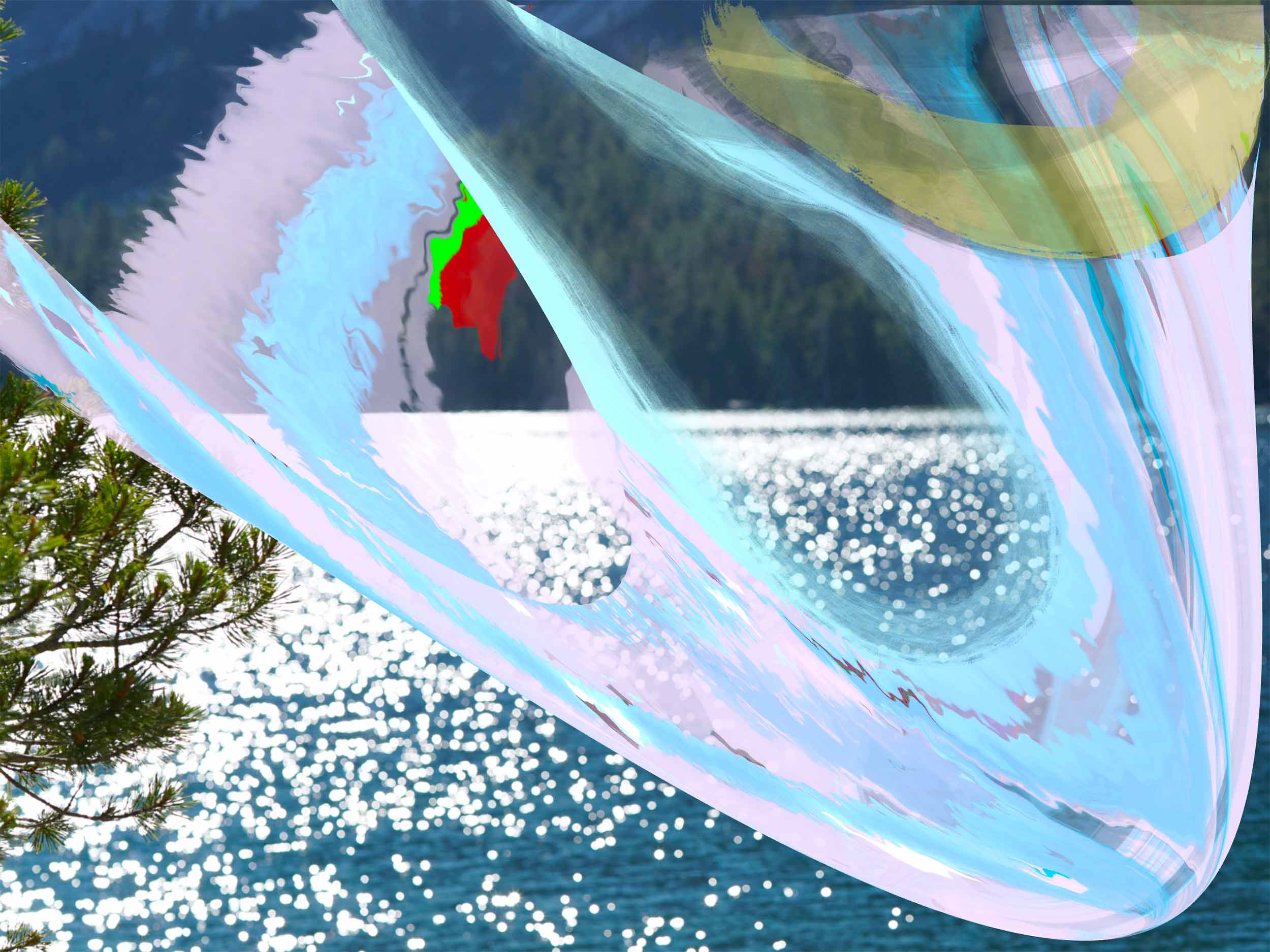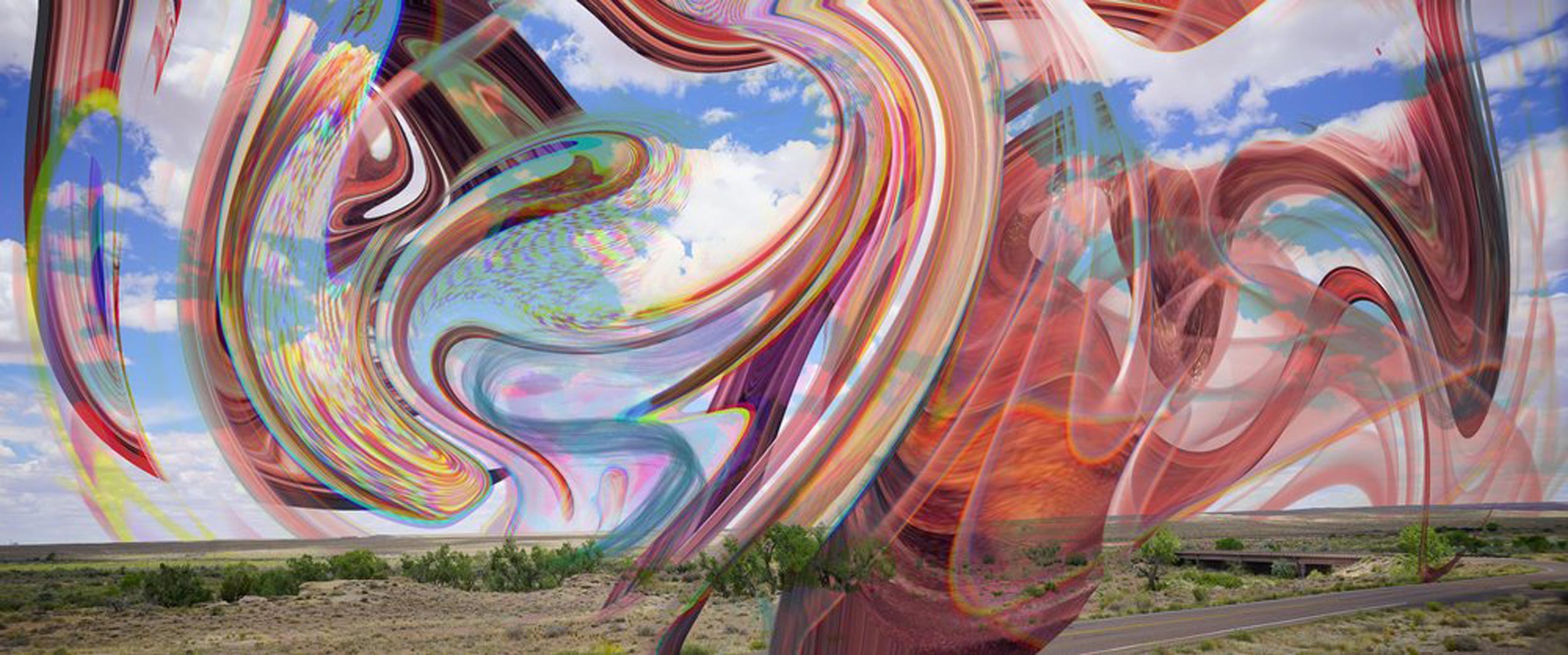Following a showcase in group exhibition ‘ANTI•VENOM,’ the artist joins Document to discuss her AI-influenced creative practice
In Amelia Winger-Bearskin’s artwork, glitchy rainbows spiral out across bucolic landscapes. The holograms shift with the surreal logic of a psychedelic vision, their colors bending and warping under the bright sun.
These hallucinatory refractions are showcased in ANTI•VENOM, a group exhibition currently on view at The Arts Center at Governors Island, curated by the nonprofit Allies in the Arts. Featuring work from Le’Andra LeSeur, Joaquin Trujillo, and Anna Parisi, among others, the show presents radical visions of the future from artists and activists. Winger-Bearskin’s contribution draws upon her background as a storyteller, technologist, and community organizer. As the founder of the AI Climate Justice Lab and the Talk to Me About Water Collective, she explores how science and storytelling can come together to address our current ecological crisis. Her work for ANTI•VENOM is a combination of AI-altered photography and experimental video art that further interrogates an idea of a technologically advanced future, begging the question: How can technology create mindfulness among its human inhabitants, rather than inhibit it?
Following the exhibition’s opening, Winger-Bearskin sits down with Document to discuss the nuances of artificial intelligence and optimistic futurism, and their larger resonance with regard to innovation and nature.
Yasmeen Khan: Why did you start incorporating artificial intelligence into your artwork?
Amelia Winger-Bearskin: The field of AI is always moving and changing so fast. The AI that I worked with at first is, in many ways, a different kind of material [than] the tools we have today: They worked differently, had different limitations, and [differed in the] ways they could surprise [us]. There isn’t a single entity called AI that’s just out there ‘in the cloud.’ AI is a huge network of people and projects and methodologies and funding models—when you work with AI, you actually get to work with a lot of different stuff. I think what all these different technologies have in common is [that] we pretend they are separate from us, even though we made them by arranging our own data in clever ways. There’s something I find really funny about that double move, where you create something and then disavow it, and [later] pretend you can’t control it anymore. There’s a lot to play with there.
Yasmeen: AI has been criticized for propagating racism, sexism, and other systemic biases. What led you to embrace it as a tool to work through these forms of oppression?
Amelia: Well, as I said before, AI doesn’t really exist as a single thing. When you read about AI issuing harsher sentencing recommendations for certain groups, or computer vision failing to recognize faces of color, these are different systems designed, deployed, and operated by different people. I don’t think it’s right to say, ‘AI did this,’ but rather, ‘This person did this [with AI].’
One dimension of AI tools that we have available today—LLMs and other models trained on large corpora—makes them [useful for]looking at systemic problems: They are excellent at distilling information from huge amounts of data, so they can be empirical. Maybe it’s better to say they can be empirical on a scale that we haven’t experienced much before, and we don’t know how to think about yet.
Yasmeen: What role do you think AI should play in artmaking?
Amelia: I think that’s a question for individual artists. Personally, I like to use AI for new animation capacities, like motion capture or editing video. For instance, [in] To Body, I use an AI tool to remove the buildings from a video I shot in New York City. I used an inpainting algorithm to erase the NYC skyline in every third frame, so you can still see the buildings, but only briefly, as traces. It might look a little rough, but lets me say, New York City without the buildings. Using a new tool incorrectly reminds us that with backward propagating technologies like AI, we erase a possible future—we could even erase ourselves. Energy-intensive systems [like AI are] reliant on fossil fuels. It’s not just that [AI] lets you make moves quicker, or more cheaply, it also lets you make new kinds of moves.
Yasmeen: I’m struck by the natural landscapes in this exhibition—the empty desert, the glistening water, the open sky. What role does the environment play in your work?
Amelia: Those are images of the real world. I shot those images on a regular camera while driving across the country, moving from the West Coast to the East Coast—it is simply landscape photography. I like to use photographs as raw material, which I then manipulate in different ways. The contrast between the natural world and the world of technology is part of [my work]. But also on a purely aesthetic level, I respond to those kinds of images more strongly than I do to, say, particle systems, point clouds, pixels, or a lot of the other aesthetic building blocks that have been commonly used ‘at the intersection of art and technology.’ I should hope they do—I took them in the first place! When you have recognizable forms as the basis of a piece, then you can more clearly recognize the interventions that the technology is making.
“We have yet to see technology that is invented solely to preserve, protect, and empower our natural systems, but we must begin to visualize what that looks like, and we will.”
Yasmeen: In these pieces, you have augmented depictions of nature through the use of AI. What do you take to be the relationship between nature and technology?
Amelia: Technology is a naturally developing strategy. We humans obviously do quite a bit with it, but we’re not the only species to have tech. Chimpanzees use sticks to gather little grubs to eat, and otters have been known to keep their favorite shell-smashing rocks with them for a long time.
I hear a lot of people talk about nature and technology using the word ‘versus.’ But it’s not really a competition—or maybe, believing it’s a competition is the surest way to lose. When I hear someone say something like, ‘Man has once more exerted dominion over nature,’ I just laugh. Like, who do humans think we are? We can’t even see ultraviolet light; we are missing out on a whole other aesthetic universe that bees, reindeer, butterflies, birds, turtles, fish, and more can see.
Yasmeen: How does your work speak to the climate crisis and the ecological reckoning it has
provoked?
Amelia: This is a question we think about a lot with my group Talk to Me About Water, where we do science storytelling specifically on water and the various water crises around the world, which, of course, climate change is making more severe. I like to think that my work celebrates the natural world at the same time as it celebrates technology. I want to imagine a version of the future in which there’s less antagonism between nature and technology, where the two impulses can live in a more elegant harmony together. I want to make this future so appealing, so intuitive to people’s imaginations that it becomes inevitable. We have yet to see technology that is invented solely to preserve, protect, and empower our natural systems, but we must begin to visualize what that looks like, and we will. Any technology that can only destroy and not build, I believe we will abandon—someday.









